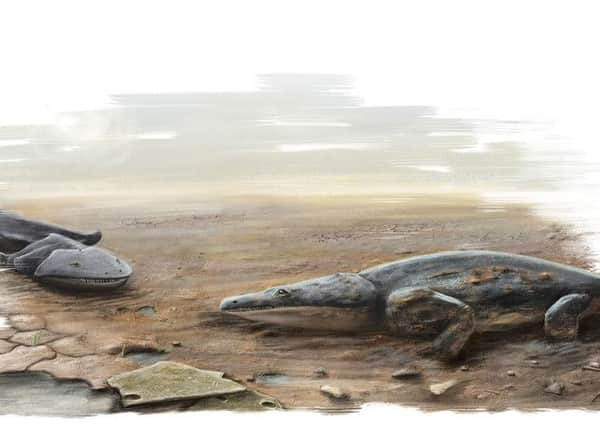Fossil of fierce ‘super-salamander’ found by Scots


The crocodile-like amphibian was the size of a small car and had jaws like a “toilet seat” lined with hundreds of razor-sharp teeth.
It lived more than 200 million years ago, at the dawn of the dinosaur age, and would have been among the planet’s top predators at the time.
Advertisement
Hide AdAdvertisement
Hide AdThe creatures grew up to 2m in length and lived in freshwater lakes and rivers during the late Triassic period, feeding mainly on fish and reptiles that strayed too close to the water’s edge.
The researchers, led by Dr Steve Brusatte of the University of Edinburgh’s School of GeoSciences, discovered the bones buried at the site of an ancient lake in the Algarve area of southern Portugal in 2009.
Now, after years of painstaking work, the researchers have identified the remains as a new species.
It has been named Metoposaurus algarvensis in recognition of the place it was found.
“This new amphibian looks like something out of a bad monster movie,” said Dr Brusatte.
“It was as long as a small car and had hundreds of sharp teeth in its big flat head, which kind of looks like a toilet seat when the jaws snap shut.
“It is an ancestor of the living amphibians but of course it lived 220 or 230 million years ago.
“It’s a weird animal from out of time, something that crawled out of the black lagoon.
Advertisement
Hide AdAdvertisement
Hide Ad“It was the type of fierce predator that the very first dinosaurs had to put up with if they strayed too close to the water, long before the glory days of Tyrannosaurus rex and Brachiosaurus.”
Dr Richard Butler, of the School of Geography, Earth and Environmental Sciences at the University of Birmingham, said: “Most modern amphibians are pretty tiny and harmless.
“But back in the Triassic these giant predators would have made lakes and rivers pretty scary places to be.”
The species is distant and primitive forerunner of today’s frogs, toads, newts and salamanders, according to the team, but the discovery reveals this group of amphibians was more geographically diverse than previously thought.
As well as being a new species, it is the first of its type discovered in the Iberian Peninsula.
The species is part of a wider group of primitive amphibians that were widespread at low latitudes between 220 and 230 million years ago, according to the researchers.
It would have laid soft eggs much like frog spawn, which would in turn have become tadpoles that would go on to develop legs.
Fossil remains of species belonging to the group have been found in parts of modern-day Africa, Europe, India and North America, but differences in the skull and jaw structure of the Portuguese fossils revealed it to be a separate species.
Advertisement
Hide AdAdvertisement
Hide AdDr Brusatte and his team discovered the remains in a large bed of bones where several hundred of the creatures may have died when the lake they lived in dried up.
Only a fraction of the site – around four square metres – has so far been excavated, but the team has already uncovered a giant reptile in the same place and will continue working there in the hope of unearthing other new fossils.
Dr Brusatte added: “In the past these kind of animals would have lived in Britain - there are some fossils from this country, not this exact kind but fairly close relatives.
“In Portugal we have found many of these, maybe hundreds, killed very quickly at once and buried together in a big bone bed.
“There is still a bit of a mystery there. We have just scratched the surface because it takes a lot of time to go through bone by bone and remove everything.
“There are bones everywhere when you dig. It is really a pretty spectacular site.
“It’s basically a jumble of skeletons all bundled together. There are all these different kinds of bones - there is literally bones everywhere.”
FOLLOW US
SCOTSMAN TABLET AND MOBILE APPS